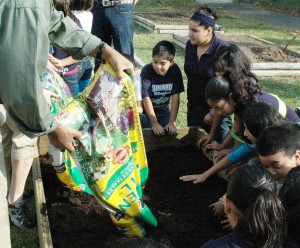Farm & Ranch
AgriLife Extension’s Texas Grow! Eat! Go! program receives top award for diversity

By: Paul Schattenberg
COLLEGE STATION – The Texas Grow! Eat! Go! program of the Texas A&M AgriLife Extension Service has received the National Extension Diversity Award from Cooperative Extension and the U.S. Department of Agriculture’s National Institute of Food and Agriculture.
The Texas Grow! Eat! Go! program has received a top award for diversity from the U.S. Department of Agriculture — National Institute of Food and Agriculture a national Cooperative Extension association. (Texas A&M AgriLife Extension Service graphic)
The program is a five-year collaboration among AgriLife Extension, the University of Texas School of Public Health, Texas A&M University and the Texas A&M Health Science Center School of Public Health. The goal is to improve the physical activity and eating behaviors of children and families, especially in low-income and underserved areas.
The award will be presented during the annual meeting of the Association of Public and Land-grant Universities Nov. 15-17 in Indianapolis.
According to the USDA-NIFA, the National Diversity Award recognizes an Extension program exhibiting significant contributions and accomplishments in achieving and sustaining diversity and pluralism.
“The primary goal of the program is to help combat youth obesity by reversing unhealthy weight trends and influencing youth to develop better eating habits,” said Dr. Susan Ballabina, AgriLife Extension associate director for program development, College Station.
The Texas Grow! Eat! Go! program is currently being implemented at 32 Title I elementary schools in four counties. Those providing program support include AgriLife Extension agents for horticulture, family and consumer sciences, urban youth development and 4-H youth development, as well as employees of the agency’s Expanded Food and Nutrition Education and Better Living for Texans programs, and the Prairie View A&M Cooperative Extension Program. It is also supported by volunteers from the agency’s Master Gardener and Master Wellness programs and by parent volunteers recruited by the schools.
“Currently we present the program primarily in Title 1 urban elementary schools with a high degree of ethnic diversity,” Ballabina said. “Youth enrollment in the program is 46 percent Hispanic and 25 percent African-American, with 44 percent of the participants indicating some degree of family food insecurity.”
Ballabina said the problem of child obesity is particularly acute in Texas where one in three children and nearly half of Hispanic children are overweight or obese.
She said the program has been successful as the result of marshaling various AgriLife Extension resources and programs focused on improving nutrition and physical activity.
“The agency’s Junior Master Gardener and Walk Across Texas programs have been particularly involved in this initiative,” she said. “The JMG program is a youth gardening program designed to ignite a passion for learning, success and service through gardening.
Youth gardening is one of the activities emphasized by the Texas Grow! Eat! Go! program. (Texas A&M AgriLife Extension Service photo by Paul Schattenberg)
“And Learn! Grow! Eat! and Go! is a new research-based, curriculum spin-off project of the International Junior Master Gardener program that combines academic achievement, gardening, nutritious food experiences, physical activity, and school and family engagement. Walk Across Texas is a statewide eight-week community-based physical activity program that uses friendly competition to help get people moving.”
Ballabina said the program has produced a significant change in participating children trying, consuming and choosing vegetables, increasing physical activity, decreasing the time on the computer or watching television, and improving the availability of fresh fruits and vegetables in the home.
“Obesity rates fell from 57 percent before intervention to 39 percent post-intervention,” she noted.
Ballabina said the program is now being introduced across Texas and nationwide through train-the-trainer workshops and a bilingual “Learn! Grow! Eat! Go!” curriculum available through the international Junior Master Gardener network, http://jmgkids.us/LGEG.
“This program is an example of the importance and efficacy of bringing AgriLife Extension instruction and information to the community,” she said. “Through the synergy of various agency personnel working together toward a common goal under the Grow! Eat Go! banner, we have been able to make a significant impact on improving the health and quality of life for hundreds of young people in this state.”
-30-
Find more stories, photos, videos and audio at http://today.agrilife.org
Farm & Ranch
Managing Show Cattle Through The Winter

By Heather Welper
Husband and wife duo, Heather and Calvin Welper, are the Co-Owners and Operators or Two C Livestock, located in Valley View, Texas.
The pair’s operation has a show cattle focus where they raise and sell purebred heifers of all breeds and club calf Hereford steers.
When it comes to show cattle, the Welpers know a thing or two including how to prepare for the cold winter months and the Texas major show season run.
To read more, pick up a copy of the November edition of North Texas Farm & Ranch magazine, available digitally and in print. To subscribe by mail, call 940-872-5922.

Farm & Ranch
Double M Ranch & Rescue

By Hannah Claxton, Editor
As the sun rises each day, so do the dozens of mouths that Meghan McGovern is responsible for getting fed. Rather than the sounds of a rooster crowing, McGovern hears the bellows and bleats of a variety of exotic deer, the chortle of kangaroos, the grunts of water buffaloes, and the chirps of a lemur.
Nestled against the banks of the Red River, the Double M Ranch and Rescue, with its high game fences and deer sprinkling the landscape,s its in stark contrast to the surrounding ranches.
“Having deer is kind of like eating potato chips- you can never actually have just one,” said McGovern with a laugh.
McGovern has several herds to take care of- fallow deer, axis deer, water buffalo, goats, and bison. In smaller numbers, there’s also a few kangaroos, a lemur, a potbelly pig, a pair of zebras, a watusi, and a few horses.
To read more, pick up a copy of the November edition of North Texas Farm & Ranch magazine, available digitally and in print. To subscribe by mail, call 940-872-5922.

Farm & Ranch
Acorn Toxicity

By Barry Whitworth, DVM, MPH
With the prolonged drought, most pastures in Oklahoma end up in poor condition. With the lack of available forage, animals may go in search of alternative foods.
If oak trees are in the pastures, acorns may be a favorite meal for some livestock in the fall. This may result in oak poisoning.
Oak leaves, twigs, buds, and acorns may be toxic to some animals when consumed.
To read more, pick up a copy of the November edition of North Texas Farm & Ranch magazine, available digitally and in print. To subscribe by mail, call 940-872-5922.

-

 Country Lifestyles2 years ago
Country Lifestyles2 years agoScott & Stacey Schumacher: A Growth Mindset
-

 Country Lifestyles8 years ago
Country Lifestyles8 years agoStyle Your Profile – What your style cowboy hat says about you and new trends in 2017
-

 HOME8 years ago
HOME8 years agoGrazing North Texas – Wilman Lovegrass
-

 Outdoor10 years ago
Outdoor10 years agoButtercup or Primrose?
-

 Country Lifestyles5 years ago
Country Lifestyles5 years agoAmber Crawford, Breakaway Roper
-

 Country Lifestyles9 years ago
Country Lifestyles9 years agoJune 2016 Profile – The man behind the mic: Bob Tallman
-

 Equine1 year ago
Equine1 year agoThe Will to Win
-

 Country Lifestyles8 years ago
Country Lifestyles8 years agoDecember 2016 Profile, Rusty Riddle – The Riddle Way






